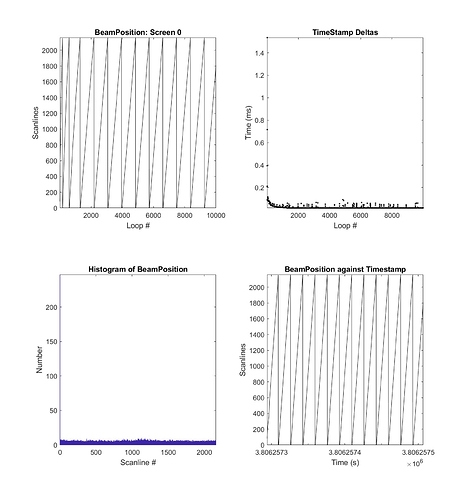Dear experts:
I have:
- PTB 3.0.16 - Flavor: beta
- Windows 10
- Matlab R2020a
I get a lot of error messages about beamposotion/timing. I’m not sure if they are related. I’m running an experiment where I am basically flashing pictures, and receiving response. I’m also sending an audio trigger via portaudio. I have tests checking the presentation durations of the stimuli, so if they differ slightly (a couple of ms) from what is intended I can measure it once to estimate it and it’s fine. What I don’t want is that it is highly unstable (order of tens of ms) so that I can’t estimate the uncertainty in duration presentation.
Outputs:
PTB-WARNING: PsychOSOpenOnscreenWindow: Failed to switch Windows-8+ desktop compositor to realtime scheduling! Expect additional timing and performance problems!!
PTB-WARNING: Call to PsychAvSetMmMaxThreadCharacteristics() for Vista-MMCSS scheduling failed for threadhandle 00007FF942FDA4E0. Setting thread priority to HIGHEST as a work-around…
PTB-INFO: The detected endline of the vertical blank interval is equal or lower than the startline. This indicates
PTB-INFO: that i couldn’t detect the duration of the vertical blank interval and won’t be able to correct timestamps
PTB-INFO: for it. This will introduce a very small and constant offset (typically << 1 msec). Read ‘help BeampositionQueries’
PTB-INFO: for how to correct this, should you really require that last few microseconds of precision.
PTB-INFO: Btw. this can also mean that your systems beamposition queries are slightly broken. It may help timing precision to
PTB-INFO: enable the beamposition workaround, as explained in ‘help ConserveVRAMSettings’, section ‘kPsychUseBeampositionQueryWorkaround’.
PTB-ERROR: Screen(‘Flip’); beamposition timestamping computed an impossible stimulus onset value of 3437258.871335 secs, which would indicate that
PTB-ERROR: stimulus onset happened before it was actually requested! (Earliest theoretically possible 3437258.876531 secs).PTB-ERROR: Some more diagnostic values (only for experts): rawTimestamp = 3437258.881398, scanline = 1303
PTB-ERROR: Some more diagnostic values (only for experts): line_pre_swaprequest = 654, line_post_swaprequest = 667, time_post_swaprequest = 3437258.876622
PTB-ERROR: Some more diagnostic values (only for experts): preflip_vblcount = 0, preflip_vbltimestamp = -1.000000
PTB-ERROR: Some more diagnostic values (only for experts): postflip_vblcount = 0, postflip_vbltimestamp = -1.000000, vbltimestampquery_retrycount = 0PTB-ERROR: This error can be due to either of the following causes:
PTB-ERROR: Very unlikely: Something is broken in your systems beamposition timestamping. I’ve disabled high precision
PTB-ERROR: timestamping for now. Returned timestamps will be less robust and accurate.PTB-ERROR: The most likely cause would be that Synchronization of stimulus onset (buffer swap) to the
PTB-ERROR: vertical blank interval VBL is not working properly, or swap completion signalling to PTB is broken.
PTB-ERROR: Please run the script PerceptualVBLSyncTest to check this. With non-working sync to VBL, all stimulus timing
PTB-ERROR: is futile. Also run
OSXCompositorIdiocyTest on macOS. Also read ‘help SyncTrouble’ !
I have run the BeampositionTest and this is the output. The only thing that worries me is that the queries seem to the on the order of 50-100 microseconds. Output is attached.
THANK SO MUCH!!!
